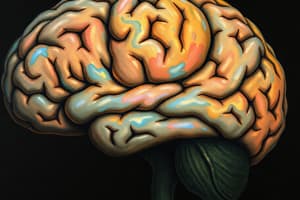Podcast
Questions and Answers
Which part of the brain is primarily responsible for reasoning and information processing?
Which part of the brain is primarily responsible for reasoning and information processing?
- Cerebellum
- Hypothalamus
- Cerebrum (correct)
- Pons
What is the main function of the medulla?
What is the main function of the medulla?
- Managing voluntary movements
- Processing sensory information
- Connecting the spinal cord to the brain (correct)
- Regulating sleep and wake cycles
Which lobe of the brain is primarily associated with vision?
Which lobe of the brain is primarily associated with vision?
- Temporal lobe
- Parietal lobe
- Occipital lobe (correct)
- Frontal lobe
Which structure of the brain controls urges related to eating and drinking?
Which structure of the brain controls urges related to eating and drinking?
What is the primary role of the cerebellum?
What is the primary role of the cerebellum?
What type of actions does the spinal cord primarily manage?
What type of actions does the spinal cord primarily manage?
Which glands are specifically identified as producing gametes in males and females?
Which glands are specifically identified as producing gametes in males and females?
What type of nerve impulses occur during a reflex action?
What type of nerve impulses occur during a reflex action?
What is the primary role of cranial nerves in the peripheral nervous system?
What is the primary role of cranial nerves in the peripheral nervous system?
Which of the following responses is regulated by the mid and hind brain?
Which of the following responses is regulated by the mid and hind brain?
Flashcards are hidden until you start studying
Study Notes
Central Nervous System
- The central nervous system (CNS) consists of the brain and spinal cord.
- The brain controls bodily functions like movement, senses, and thoughts.
- The spinal cord connects the brain to the peripheral nervous system, transmitting signals between the two.
Brain Regions
- The brain is divided into three regions: forebrain, midbrain, and hindbrain.
Forebrain
- The forebrain, the largest region, is responsible for cognitive functions and sensory input.
- It includes the cerebrum, which controls voluntary motor actions, sensory perceptions, learning, and memory.
- The cerebrum is divided into four lobes:
- Frontal: controls voluntary muscle movements, memory, and speech.
- Parietal: processes senses of touch and taste.
- Temporal: processes senses of smell and hearing.
- Occipital: responsible for vision.
Midbrain
- The midbrain contains the hypothalamus.
- The hypothalamus controls basic needs like hunger, thirst, sleep, and wakefulness.
Hindbrain
- The hindbrain connects the spinal cord to the rest of the brain and consists of the cerebellum, medulla, and pons.
- The cerebellum controls movement, balance, and coordination.
- The medulla controls involuntary actions like heartbeat, breathing, and reflexes like swallowing and vomiting.
- The pons regulates respiration.
Peripheral Nervous System
- The peripheral nervous system (PNS) connects the CNS to the rest of the body.
- It consists of cranial nerves and spinal nerves.
- There are 12 pairs of cranial nerves that extend from the brain to organs in the head.
- There are 31 pairs of spinal nerves that extend from the spinal cord to organs below the head.
Types of Nerves
- There are three types of nerves in the PNS:
- Cranial nerves: originate from the brain.
- Spinal nerves: originate from the spinal cord.
- Visceral nerves: connect to internal organs.
Reflex Actions and Reflex Arc
- A reflex action is an automatic, rapid response to a stimulus, like the knee jerk or withdrawing a hand from a hot object.
- The reflex arc is the pathway nerve impulses take during a reflex action.
- The reflex arc involves a series of steps:
- Stimulus
- Receptors (e.g., skin)
- Sensory neurons
- Spinal cord
- Motor neurons
- Effector organ (e.g., muscles)
- Response (e.g., hand withdraws).
Types of Actions
- There are three types of actions in the nervous system:
- Voluntary actions: controlled by the forebrain, such as talking and writing.
- Involuntary actions: controlled by the midbrain and hindbrain, such as heartbeat, vomiting, and respiration.
- Reflex actions: controlled by the spinal cord, such as withdrawing from a hot object.
Studying That Suits You
Use AI to generate personalized quizzes and flashcards to suit your learning preferences.




